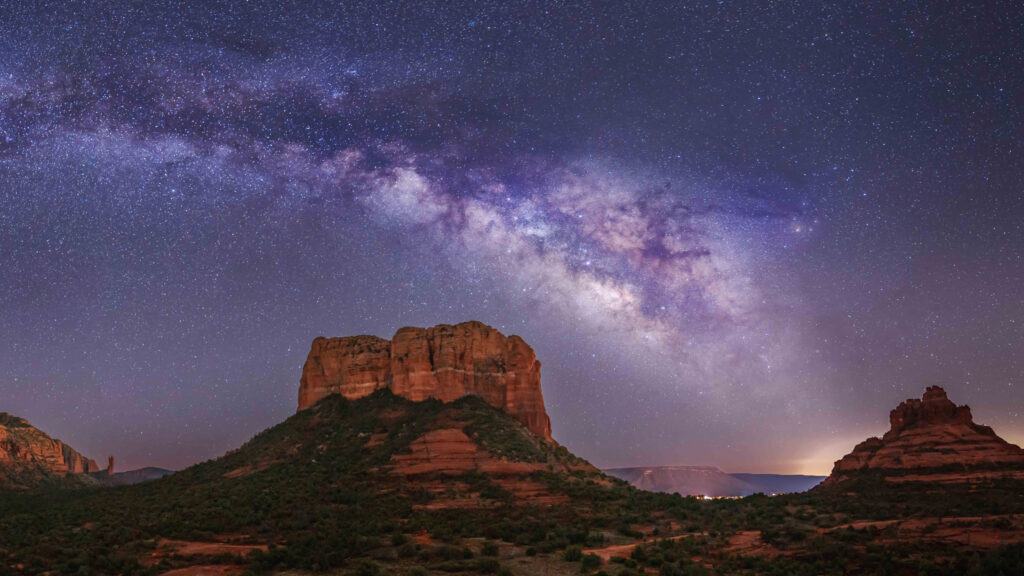If you’re someone who enjoys browsing through cookbooks, food magazines, or restaurant menus, you surely have noticed the importance of food photography in capturing your attention. But what is it that sets a magazine spread apart from say, food photography on packaging? Editorial food photography is a type of food photography that emphasizes the storytelling aspect of food. It’s a way to bring the viewer in and sell them on more than just the food, but a feeling and the whole culinary experience so you can feel like you were there or excite you to recreate the experience for yourself.
But your images don’t have to end up in a magazine to take a page out of the editorial food photography book. (Let’s be honest, we all secretly want to be on the cover of our favorite food mag, right?) Editorial food photography is less about where the images are published and more about the stories they tell and the connections they create. By leaning into the story, editorial food photography appeals to our imagination and invites us to linger a little longer before turning the page.
I believe that everyone, from hobbyist to professional, can add an editorial flare to their food photography. With the principles of editorial food photography, and at least two types of camera lenses, you can capture everything from the bread and butter to the intangible dishes brought to the table: kindness, generosity, happiness, and love. So in collaboration with SIGMA, we conducted a virtual workshop full of food photography tips to show you how!
My Food Photography Gear
- SIGMA 40mm F1.4 DG HSM | Art lens
- SIGMA 24-70mm F2.8 DG OS HSM | Art lens
- Your favorite macro lens (some great options below)
- Dapple Pro
- Canon EOS R5 Mirrorless Camera with Canon Mount Adapter EF-EOS R
- Manfrotto Aluminum 4-Section Tripod
- Tether Tools Tether Cord
- Flashpoint XPLR 600 Pro Strobes
- EZ Glow 48″ Softbox
- C-Stands
- V-Flat World Foldable V-Flat
Capturing the Hero Image with a 40mm Prime Lens
We wanted to go all-out, telling the story of a holiday meal with a showstopping first course: a bountiful winter salad. Our graphic designer created templates for a four-page magazine spread, complete with the recipe, flavor text, and headings. This way, we were able to compose our image with the magazine layout in mind. In fact, we imported the template as an overlay in Lightroom so we could see exactly how it would look in the finished product.
Want to try it? Download our free Canva template and overlay files (courtesy of Little Rusted Ladle)
When I want to focus on storytelling while photographing food (which is a lot) I make sure to use multiple types of camera lenses. I tend to favor prime lenses over zoom lenses, but both have their strengths. Using more than one prime lens helps me capture the highest quality, widest variety of images from a single shoot.
I can get a wide angle of the whole set to establish an environment and then switch to macro food photography for the smaller, more delicate features of the dish. This results in an abundance of content and a fuller picture of the scene.
To start, we set up our hero shot. In our layout, this image would likely end up as the cover and/or the first page of our magazine spread. To capture the whole atmosphere of our holiday feast we mounted our camera overhead with the SIGMA 40mm F1.4 DG HSM | Art lens attached.
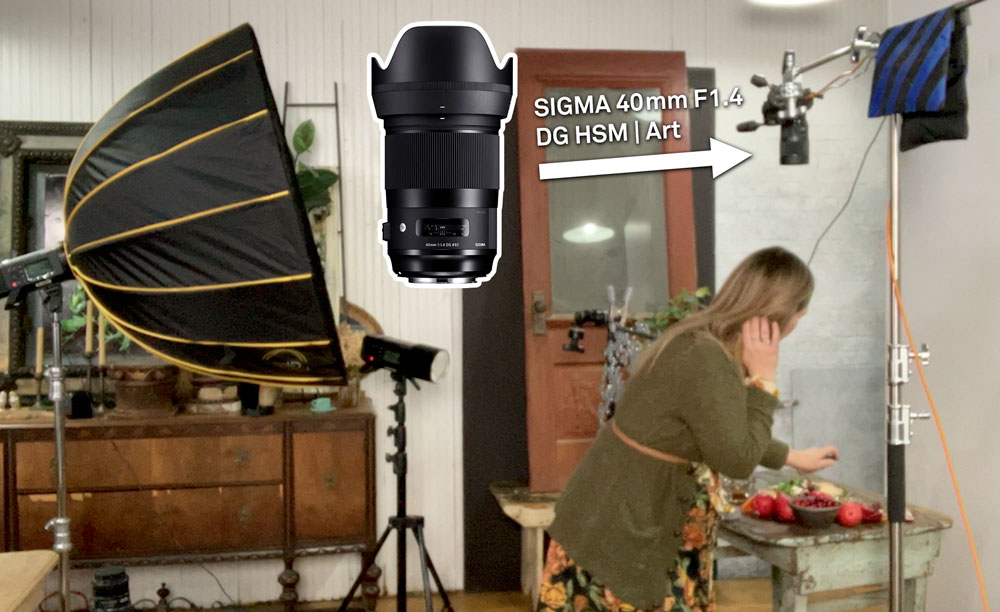
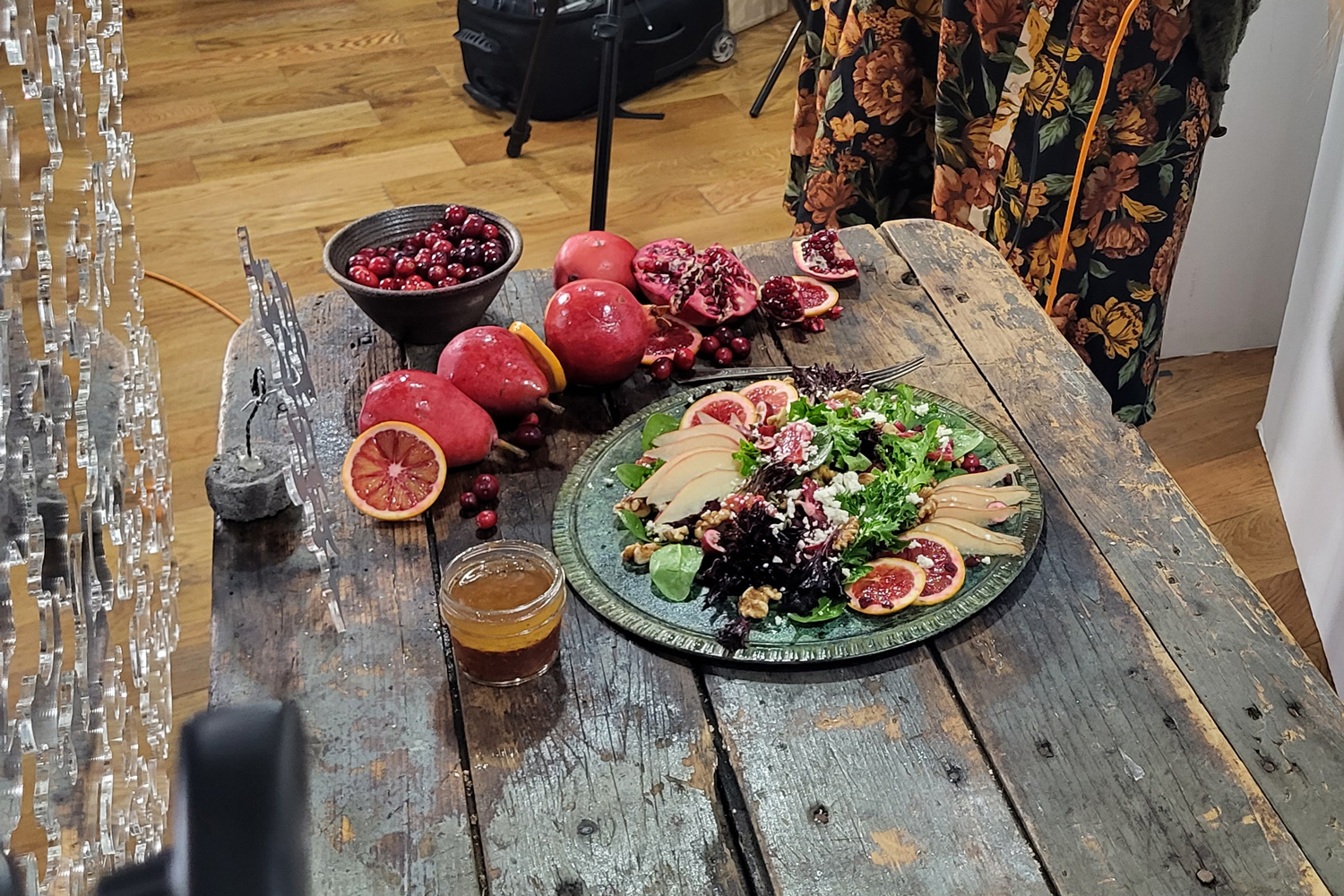
The 40mm is a moderate wide-angle lens which gives you a wider field of view and helps capture the environment or setting in which the food is being served without the camera having to be super far away. The silverware, jar of vinaigrette, and red pear and cranberry fizz all add to the festive place setting, allowing the viewer to imagine the rest of the holiday table.
With the help of our overlay, strategic areas of the composition are left open to accommodate text. It’s a win-win in editorial food photography, because the text will be clean and legible, and we won’t lose any of our composition or vibrancy to a scrim or other graphic design to be able to read the article.
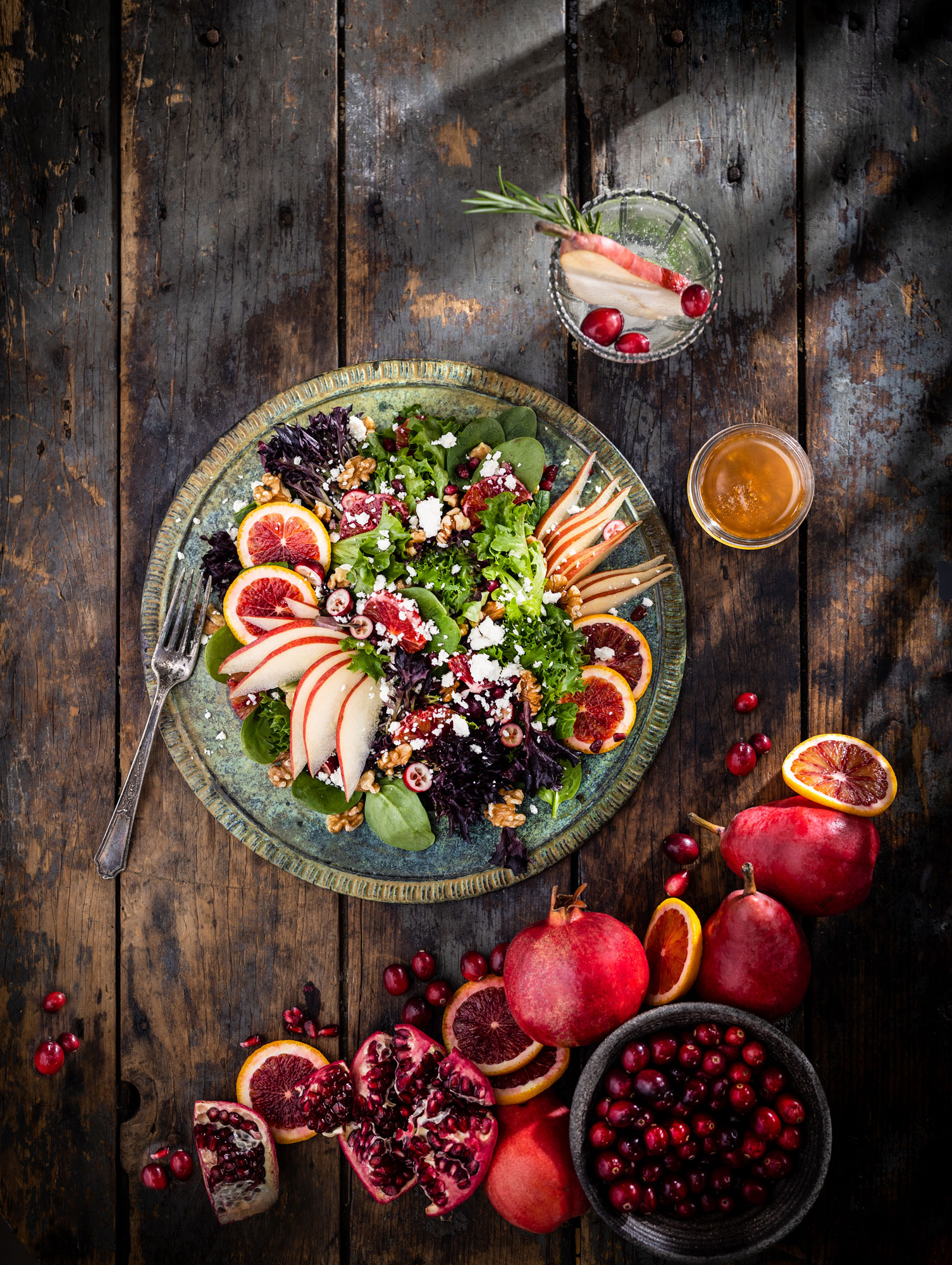
We also styled a spray of fresh ingredients to help fill out the frame, continue the color themes, and increase appetite appeal. Obviously, If this were my real holiday table, I wouldn’t have the fruit spread out like this. But part of the joy of editorial photography is its freedom from realism. Were this my real holiday table, I may have arranged a centerpiece of red pears, pomegranates, blood oranges, and cranberries. To tell the story I was reaching for in this one frame, we chose to add those elements in while leaning into beauty and away from realism.
Our other big storytelling device is the light. I decided to set our scene in a dining room with a lot of windows, on a bright, clear, snowy winter day. To achieve that, I made a couple of choices:
- I wanted a clear mix of hard and soft light so I am using two strobes.
- The key light is diffused with a large softbox, creating a soft, even light.
- The second light is a bare-bulb strobe to achieve the hard, almost glaring winter sunlight.
- Our second strobe is shooting through the Dapple Pro Cucoloris to create long, impactful shadows across the set.
As a result, the image has a blend of soft ambient light with beams of glaring hard light, imitating the reflection of the snow through the trees and windows. The hard light creates highlights that really bring out the fresh, juicy quality of the blood oranges, the shiny richness of the cranberries and pomegranate seeds, and lends visual interest to the glassware.
A Quick Lens Switch for Photographing Food and People (Me!)
Between the overhead hero shot and the handheld macro detail shots (coming up next!) I wanted to make sure we had a human element for our editorial spread. Using people when photographing food can help to personalize your shoot, making it more realistic. If you’re incorporating editorial food photography into your own holiday meals, you will have plenty of available models in your family and friends!
A zoom lens, especially the SIGMA 24-70mm F2.8 DG OS HSM | Art zoom lens that I used here, is a great option for the lifestyle elements of your editorial photo shoot. It is versatile, which is important when you’re working around an active holiday table, and not in a controlled studio space. The agility will come in handy to catch little hands reaching for Christmas cookies in the same breath as capturing Grandma passing the traditional mashed potatoes.
For the demo, the lifestyle element I chose to capture was a process shot of me washing the greens we used for the salad. Since this was a controlled environment, and I was wearing two hats as photographer and model, we set up the camera on a tripod. In our space, we had the zoom set to 70mm to get nice and close to the action without interfering with the light and our set.
With the help of my assistants, I was able to set the focus on my hands held above the bowl. Then, switching to manual focus, we were able to ensure our focus was right where it needed to be, even as I moved in the frame, trying to catch the falling water droplets.
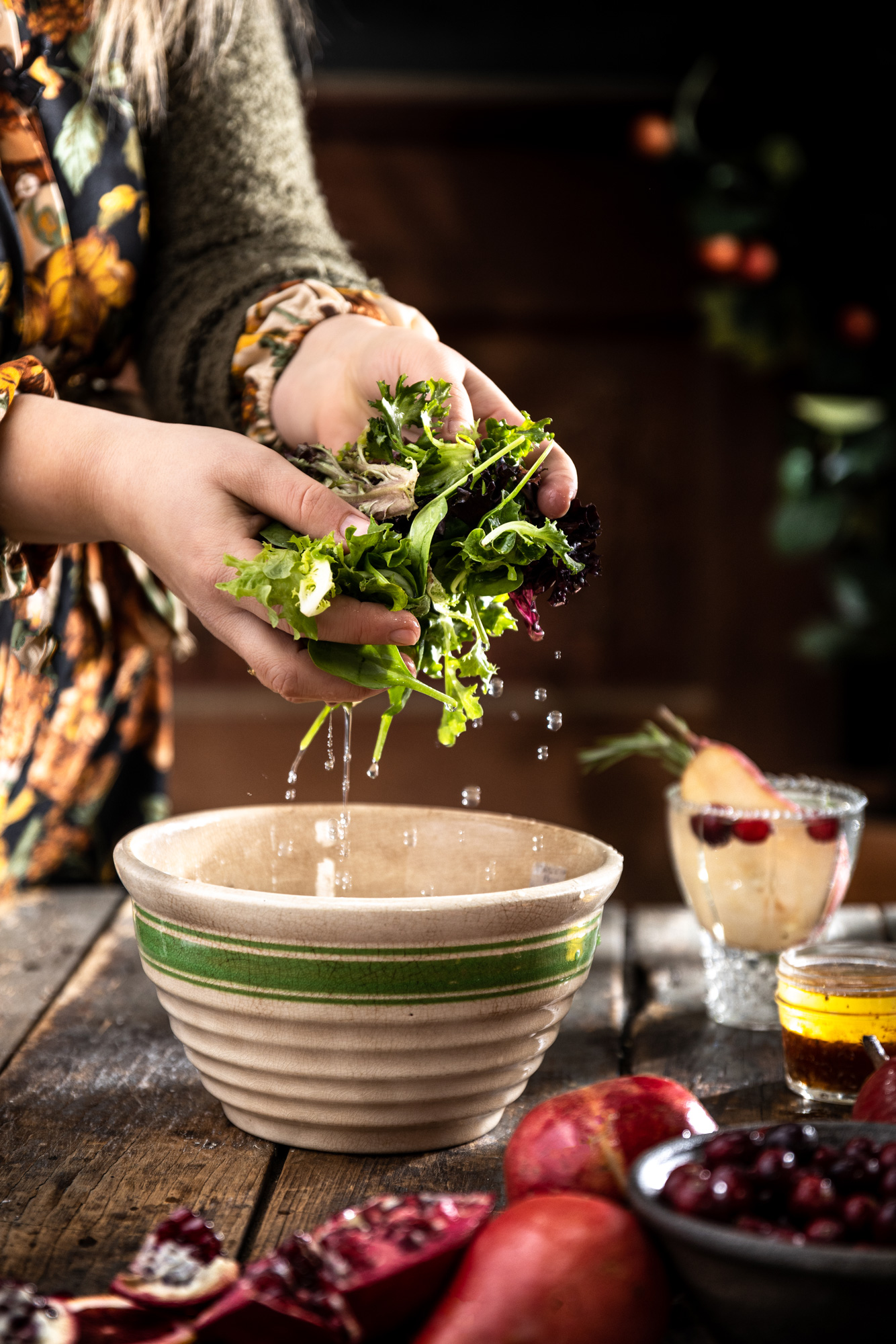
If you don’t have a willing model or the ability to rig up a lifestyle shoot with you as the subject, there are other ways to add the human element that enhances the storytelling without an actual human.
- Crumbs, or other small elements like extra sprinkles or seasonings.
- Taking a scoop out of your casserole or a slice out of your cake and styling a serving on a separate plate.
- Movement in the photo, whether that’s a drizzle of dressing, pouring a glass of wine, or steam rising from the dish.
- Silverware “in use” like a butter knife with butter on it or a fork on a plate.
Depending on your circumstances you may have more actual people in your images, or subtle hints of the people involved, but either way your whole story is going to be easier to connect with.
Detail photography with a macro lens
Once we were satisfied with the hero shot, it was time to switch it up, and capture the tiny details that the hero shot may not fully emphasize with macro food photography. In editorial terms, these would be supporting images to complete the layout. It’s a chance to direct attention to other parts of the story. In this workshop, that included:
- The red pear fizzy drink to highlight another recipe
- Close ups of the salad itself to catch smaller details that the wide shot misses
- A macro shot of the dressing with some pouring to showcase movement
- Beauty shots of our fresh ingredients
If you’re a professional photographer, these images make great potential upsells to clients and more shots for your portfolio. For the hobbyist, this is the chance to capture personal details that help flesh out the story. Maybe at your holiday meal you always get out grandma’s dishware, or the napkins were a handmade gift from a favorite aunt. All of these extra touches while photographing the food will help you remember not only the meal, but also the love, connections, and stories that accompany the experience.
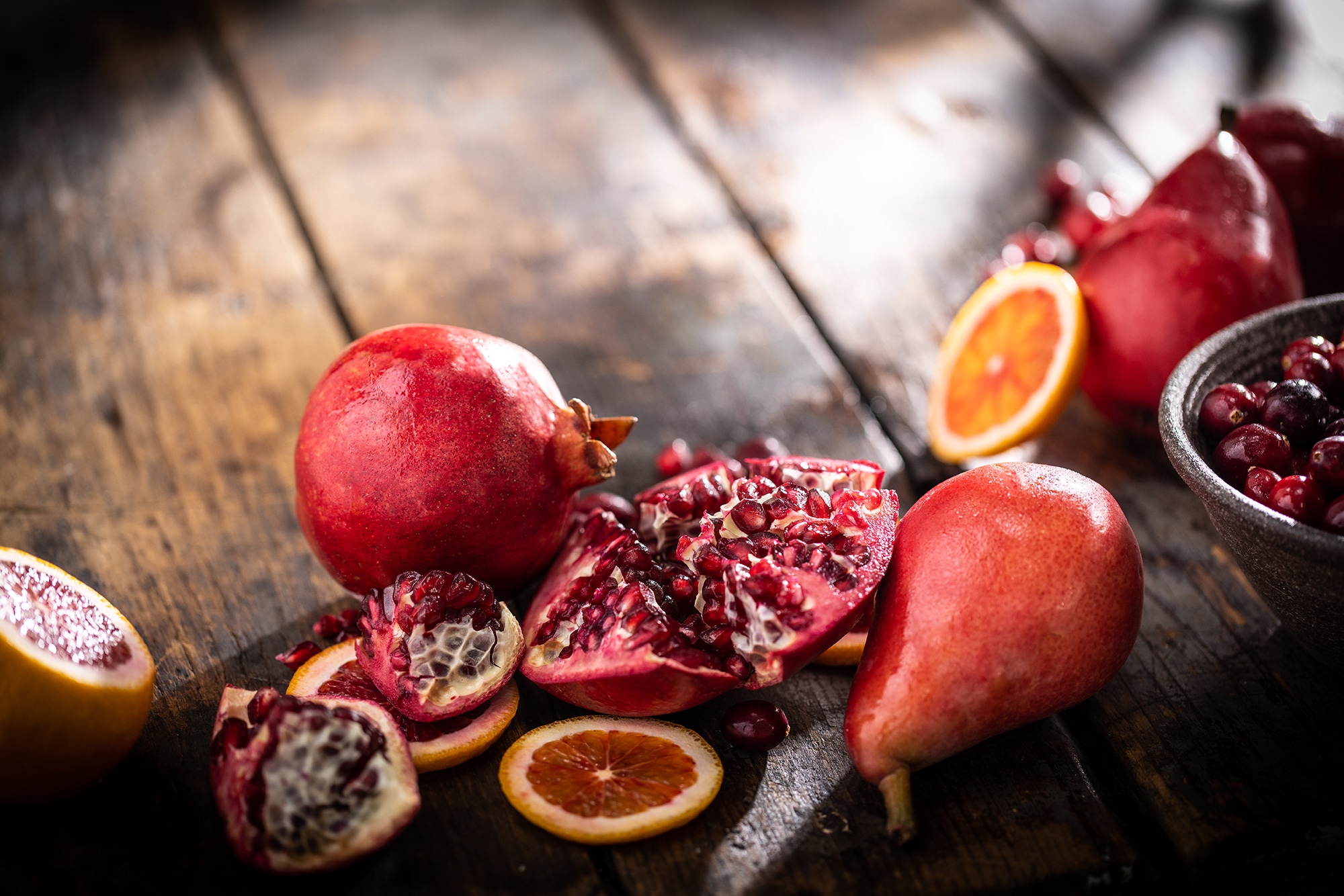
For these additional images, I like to use a macro lens, and I usually hand hold my camera. Macro lenses are favorites of mine. I use one at almost every shoot to get in close and capture the pretty details for sharp, crystal clear macro food photography. I love using a shallow depth of field in these shots for maximum effect, and a SIGMA 105mm macro lens, for example, creates a creamy, soft background.
Looking for a macro lens? SIGMA’s got you covered:
Since we already perfected our composition and lighting for the hero shot, I usually don’t have to make too many changes during this stage to capture beautiful images. I like to walk around my set, finding new, exciting perspectives, and shoot as I go. I snap whatever strikes me as beautiful and then review the images in Lightroom every so often to ensure my focus and settings are where I need them to be.
Switching between types of camera lenses was essential for this part of the process. I simply would not have been able to capture the same stunning details with the 40mm lens we used for the hero shot. It’s the range of images we were able to take that captured the totality of the experience, from the big picture to the tiniest most special components of our bountiful winter salad.
A Photojournalistic Editorial Visual Feast
To wrap up the demo, I took screenshots of my favorites and sent them to Mercadees, our graphic designer, to drop them into the layout of the recipe and food photography tips we had already created. It was so nice to see everything put together. It was quite the visual feast!
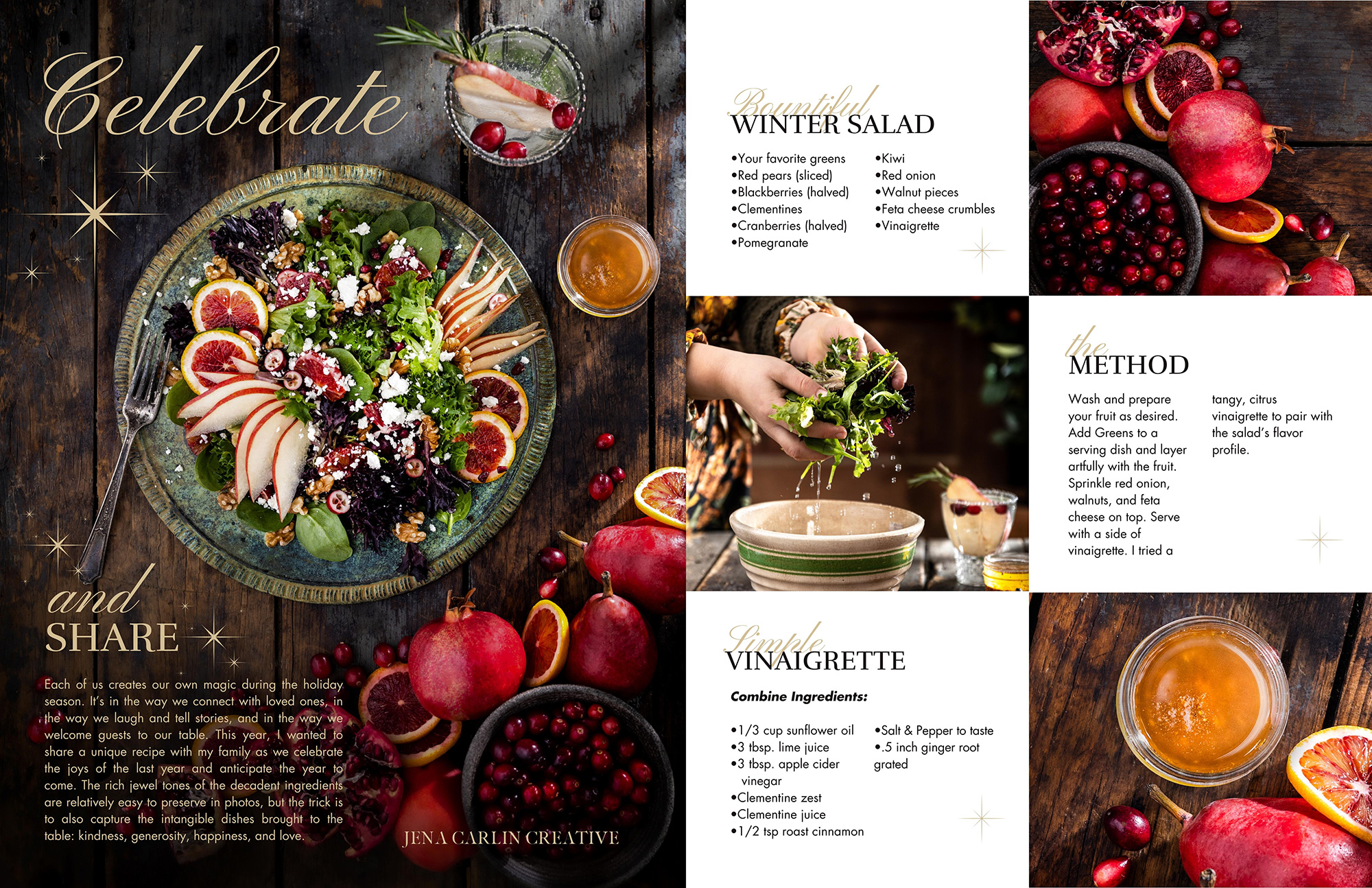
Through the course of the workshop (check out the video stream here if you missed it), we discussed 7 food photography tips to help achieve an editorial style no matter your photography level or what you’re photographing. You can check out our sister article on Little Rusted Ladle for a full rundown of the principles we discussed.
And, if you’re interested in my bountiful winter salad recipe, you can find it on the blog here.
Show Us Your Food Photography
I hope you enjoyed this brief demo in editorial food photography and are inspired to try out some of the techniques in your own work! You’re going to love what it does for your images. Let us know in the comments if you have other story-enhancing food photography tips.
We’d love to see what you create, so be sure to tag @littlerustedladle and @sigmaphoto on Instagram when you post!
Want to try the editorial template? Download our free canva template and overlay files.
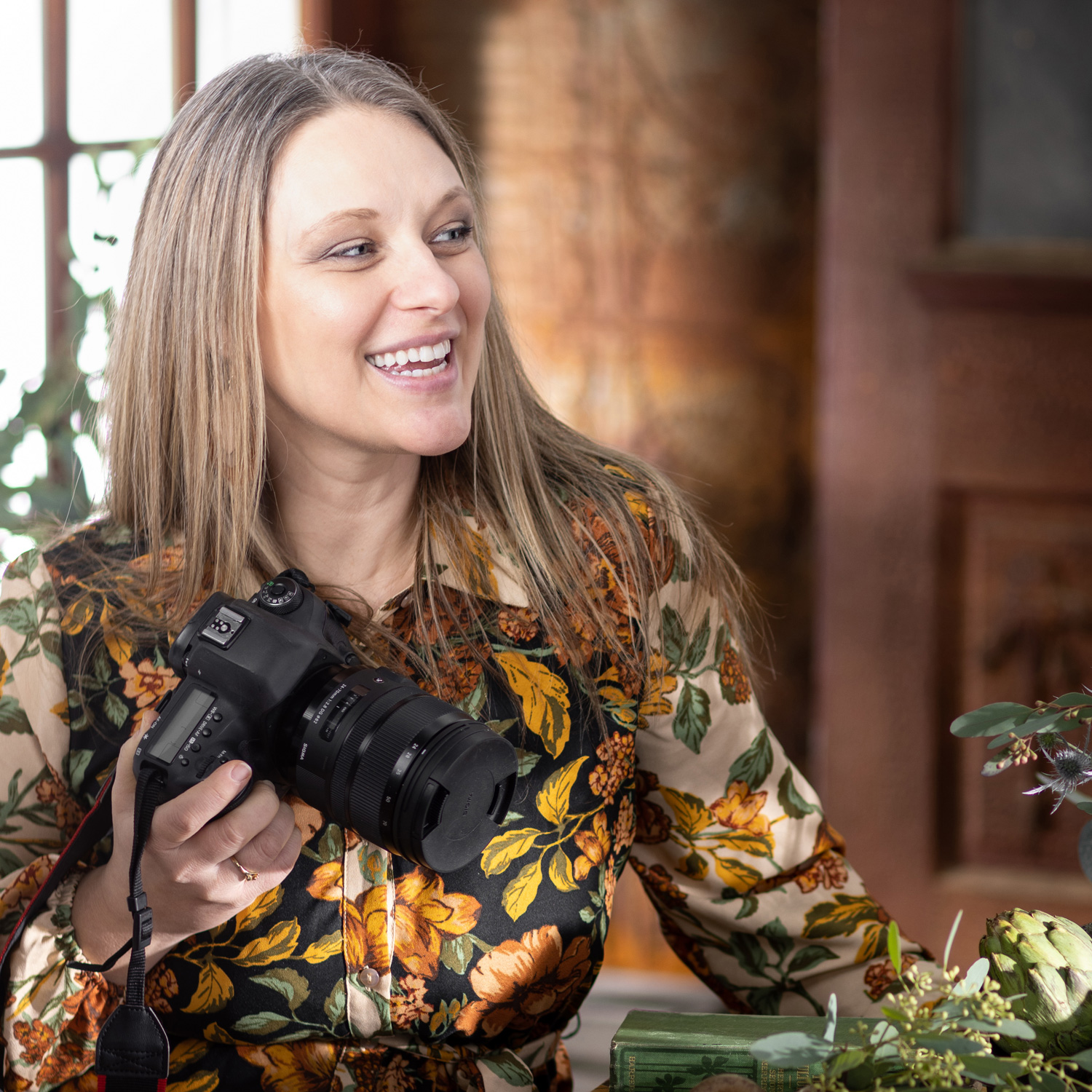
Keep in Touch and Learn More About Food Photography!
Interested in more high-level food photography education? Check out my signature mentorship program, Portfolio To Profit for photographers who want to book more commercial food photography, or my intro course Inspiration to Portfolio if you want to highly improve your skills as a food photographer.
Looking for an experienced visual storyteller to connect with your audience on your next food photography campaign? Find more of my work and book a call with me at jenacarlincreative.com.
I am excited to hear from you! In the meantime, don’t wait for a special occasion, create one!
